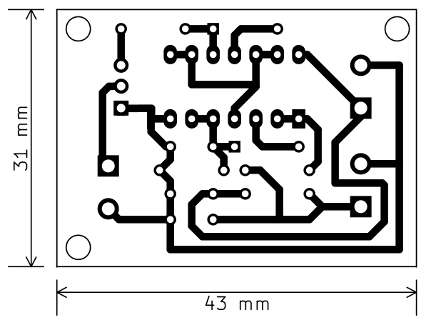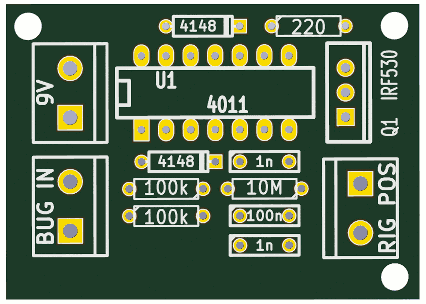Like many others, I have noticed an ugly, scratchy sound while using my Vibroplex Presentation bug. The unwanted artifact is affected by the contact setting but it is impossible to remove this completely. This problem is noticeable mostly with new “fast” transceivers like K3. My idea that this sound is caused by contact bouncing was confirmed in an older writing in QST.
Dave Cuthbert, WX7G, writes: “I’ve noticed that most bugs have “scratchy” sound. A quick look with an oscilloscope showed that “bug” dot contacts usually bounce two or three times at the start of each closure. My solution to this was to build a pulse stretcher that ignores any contact bounce that occurs within 10 milliseconds after the initial closure.
The circuit uses a 4011 CMOS NAND chip and an IRF511 60-volt, 3-ampere MOSFET. The four gates in the 4011 are connected as inverters. When the telegraph key is closed, the input of U1A goes low. The output of U1A goes high and charges C2 through D1. The discharge path of C2 is R3. The time constant of R3 and C2 causes U1B’s output to stay low for 10 milliseconds after the key opens. U1C and U1D invert the signal to drive the gate of Q1. The 220 Ω gate resistor prevents oscillations and must be mounted near Q1. If you want to key a cathode-keyed rig, you’ll need to use the 400-volt MOSFET, such as an IRF730. C1 attenuates RF energy entering the box and R2 protects the CMOS chip against static discharge. The circuit is powered by a 9-volt alkaline battery, and draws so little that the battery should last for years. All of the debouncer’s components are available at Radio Shack if you use an IRF511 instead of the IRF530.” (QST September 1992, p. 87).
To make the construction easier I decided to design a small PCB board. My software didn’t allow to connect the NAND outputs in parallel so another diode was added (marked in blue).
foil side view
(click the image to enlarge)
and the parts placement
component side view
(click the image to enlarge)
This circuit adds some weighting to the resulting code elements but it is not noticeable because the code itself is not computer generated. In addition to the dot stabilizer and careful adjustment, it removes the scratchy sound completely.
The circuit is housed in a small plastic box with three RCA connectors as inputs – two are “debounced” and the third is connected to the output, forming a “thru” path intended for my Winkeyer USB which does not need to be debounced (and also does not need any additional weighting). The whole debouncer draws very little, less than 1 µA.


